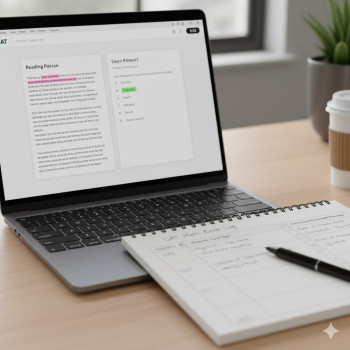Introduction: A New Chapter for the SAT
If you’ve been following the college-admissions conversation for the past few years, you’ve probably noticed a pretty big change: the SAT has gone digital. The move wasn’t just about swapping paper for screens. It changed timing, tools (hello, Bluebook and Desmos), reporting, and the way educators and students interpret scores. For high schoolers studying for the SAT today, understanding how the digital shift affects score trends is as important as mastering algebraic expressions or sharpening reading-comprehension strategies.
This post pulls together the essential ideas you need: how digital testing changes what scores mean, how trends have shifted, and practical steps you can take to prepare and adapt. Along the way I’ll include examples, a simple data table to illustrate score reporting differences, and actionable strategies. Where it naturally fits, I’ll mention how Sparkl’s personalized tutoring—1-on-1 guidance, tailored study plans, expert tutors, and AI-driven insights—can boost your preparation.
Why the SAT Went Digital (and Why It Matters)
On the surface, moving the SAT to a digital format might look like modernization for its own sake. But the change was driven by three practical goals: improved accessibility, higher security, and better alignment with the digital skills students use every day. Digital testing allows for more flexible test scheduling, individualized timing, and enhanced protections against cheating—each of which has ripple effects on scores and score interpretation.
Consider two examples:
- Individualized timing: Digital platforms can time students individually so small delays or disruptions affect each test-taker differently. This makes the testing experience fairer in many ways, but it also means simple timing strategies that worked for paper tests might not map perfectly to the digital format.
- Integrated tools: The embedded Desmos calculator and notepad features reduce the friction of switching between separate tools. For some students this improves efficiency; for others, it introduces a learning curve that can temporarily affect performance.
At-a-Glance: How Score Reporting Has Evolved
Score reporting for the Digital SAT emphasizes clarity and actionable feedback. Instead of purely raw or section scores, reports now often include skill-area insights, percentile comparisons across regions, and simpler visualizations that show where you stand relative to peers. That shift changes what “a good score” feels like: it’s not just a number, it’s a set of signals about strengths and growth opportunities.
Table: Comparing Old (Paper) vs New (Digital) Score Reporting Features
| Feature | Paper SAT (Traditional) | Digital SAT (Current) |
|---|---|---|
| Delivery | Paper test booklet; fixed time for all | Bluebook app; individualized timing |
| Tools | Separate calculators (as allowed), scratch paper | Embedded Desmos, digital notepad; optional device types |
| Score Visuals | Numeric scores with subscores | Clear visuals, skills-insights, percentiles by region |
| Question Review | Full item review in some reports | Less item-level detail in student reports; more skills mapping |
| Security | Standard paper security | Device lockdown, unique item sets, stronger proctor tools |
That table helps us see the practical differences, especially in how score feedback is delivered. The digital report is designed to be more actionable, which changes how students and tutors interpret results and plan next steps.
What the Data and Trends Show (High-Level View)
Because the format change is relatively recent, analysts and educators have been watching closely for shifts in average scores, subgroup gaps, and patterns in question-level performance. Early research and pilot studies indicate three broad points:
- Predictive validity remains: Digital SAT scores continue to predict early college performance similarly to paper SAT scores. In other words, admissions offices still get a useful signal about academic readiness.
- Score distributions shifted slightly: Average scores and subscores showed modest shifts in early administrations as students and schools adjusted to format and timing.
- Skills-level insight improved interpretation: New skill-area reporting helps pinpoint specific strengths and weaknesses, making targeted study more efficient.
These trends matter more in practice than in theory. The predictive validity point reassures students and counselors that the score still “means” something for admissions. The shifts in distributions mean schools and students should avoid comparing digital scores directly with old paper-based norms without context. And the skills breakdown presents an opportunity: targeted improvement now yields higher returns because you can see precisely which subskilles to attack.
Why Some Students See Different Scores on Digital Tests
It’s tempting to think a score change is about ability, but the testing medium introduces other factors:
- Familiarity with device and app: Students who’ve practiced on the Bluebook app and the embedded Desmos calculator often perform better because they avoid time lost to navigation.
- Test-taking strategy adaptations: Digital tests sometimes use shorter, adaptive sections or unique timing. Students who can chunk time effectively and pace themselves digitally gain an edge.
- Environmental and technical hiccups: A frozen screen or unfamiliar keyboard layout can be disruptive. Schools and test centers typically provide guidance, but small tech problems can still affect performance.
For example, a student who was an efficient paper test taker might find they need to relearn how to flag and revisit questions in the digital interface. That small change in habit can nudge scores up or down until the student grows comfortable with the platform.
Practical Preparation: Adapting Your Study Plan to the Digital SAT
Preparation that worked for the paper SAT needs a tweak for digital. The core skills—reading closely, reasoning quantitatively, solving problems—are unchanged. What’s different is the interface, timing, and reporting. Here’s a practical plan you can use over 8–12 weeks.
Eight-to-Twelve Week Digital SAT Prep Roadmap
- Weeks 1–2: Baseline & Familiarization
- Take a full-length digital practice test in the same environment you’ll use on test day (same device type, same app if possible).
- Explore the Bluebook interface: highlight, flag, calculator modes, and navigation shortcuts.
- Weeks 3–6: Targeted Skills Work
- Use skills insights from your report to build a weekly focus (e.g., “algebraic manipulation” or “multilevel argument questions”).
- Practice with short, timed sections on the app to build pacing and stamina.
- Weeks 7–8: Full Tests & Review
- Take at least two full-length digital tests under test-day conditions; review mistakes deeply using the skills framework.
- Weeks 9–12: Fine-Tuning
- Polish time management and work on specific question types where you lose time.
- Schedule a mock test day to practice logistics: device battery, login flow, and test center timing.
Sample daily routine (90 minutes): 20 minutes warm-up (vocab/quick math), 40 minutes focused practice on a weak skill, 20 minutes timed practice questions on the app, 10 minutes reflection and note-taking.
How Tutors and Personalized Support Change the Game
Targeted tutoring can compress months of solo study into weeks. Personalized 1-on-1 tutoring helps in three big ways:
- Diagnosis and focus: A tutor can interpret your digital score report and identify the high-impact areas to improve.
- Technique and habit transfer: Tutors can help translate old paper-test habits into digital-friendly strategies—how to flag, when to switch calculator modes, and how to manage the digital notepad effectively.
- Accountability and momentum: Regular check-ins and tailored homework keep progress steady and measurable.
If you’re considering extra help, Sparkl’s personalized tutoring pairs these elements—expert tutors, tailored study plans, and AI-driven insights—with practice on the digital platform to build both skill and familiarity. The benefit is practical: when you’ve already practiced the exact way you’ll test, you reduce test-day friction and free up mental energy for solving problems.
Interpreting Your Digital Score: What to Watch For
When you get your scores back, don’t just focus on the total. Pay attention to:
- Skills Insights: These are actionable—if your report flags a certain reading skill, focus practice there.
- Percentile by region: Where do you stand in your state or nationally? Context matters when comparing with historical data.
- Score ranges: Understand the reporting margin of error and how much a retake might realistically move your score.
Remember: a slightly lower score on a first digital attempt doesn’t mean you’re worse prepared long-term. It often signals a learning curve with the interface and timing, which you can close with targeted practice.
Real-World Context: Admissions and the Big Picture
Colleges are aware of the format change and, for the most part, evaluate digital and paper-era scores in context. Admissions officers look for academic rigor, course selection, grades, extracurriculars, essays, and test scores as part of a whole. That means the strategic approach to the SAT is the same as ever: maximize your score efficiently while investing time in other parts of your application.
From a counseling perspective, the digital format’s clearer skills reporting can actually help students craft stronger narratives. If your skills insights show particular strengths in quantitative reasoning or analytical reading, you can highlight those in essays or interviews with concrete examples.
Common Mistakes Students Make with the Digital SAT
- Under-practicing on the device: Using paper practice only and not the app is a frequent misstep.
- Ignoring skill breakdowns: Treating the score as a single number rather than a roadmap for improvement reduces study efficiency.
- Over-reliance on speed: Digital timing can encourage rushing; accuracy-first pacing is usually smarter.
Quick Wins: Study Tips That Work in the Digital Era
- Simulate the test environment: Practice on the same device type you’ll use on test day.
- Master the embedded calculator: Learn both scientific and graphing modes if available.
- Use the skills-insights to build micro-goals—two weeks on a single weakness beats unfocused study for two months.
- Take advantage of 1-on-1 tutoring when you need a plan and accountability. Customized guidance shortens the path to a higher score.
Putting It Together: A Sample Case Study
Imagine Maya, a junior whose baseline digital practice test showed strong math 1 performance but weaker multistep algebra and reading evidence questions. Her digital score report included skills-insights pointing to multi-paragraph inference questions and equation setup mistakes.
Maya’s plan:
- Two weeks focused on algebra setup: translating word problems to equations with daily 30-minute drills.
- Three weeks of targeted reading practice using question clusters that emphasize inference and evidence identification.
- Weekly full digital practice tests to build fluency with Bluebook and timing.
- One-on-one sessions with a tutor who helped convert paper strategies to digital workflows and reviewed her skill-area reports each week.
Result: Maya’s score rose by a meaningful margin in three months, and the targeted tutoring saved her from wasting time on low-impact activities. That’s the real advantage of pairing accurate digital feedback with focused, expert-guided practice.
Final Thoughts: Embrace the Change—But Train Smart
The shift to the Digital SAT isn’t a gimmick. It’s a practical response to a more digital learning environment and offers new tools for clarity and improvement. For students, the opportunity is to train smart: practice on the real platform, use the skills insights to focus study time, and get targeted help when patterns of mistakes repeat.
If you’re planning your study season, remember this simple mantra: simulate the test, target the weakness, and practice with purpose. Personalized support—whether from a dedicated tutor or an organized program like Sparkl that combines 1-on-1 guidance, tailored study plans, expert tutors, and AI-driven insights—can make the process smoother and more productive. It’s not about doing more; it’s about doing the right things with the right feedback.
Action Checklist: What to Do This Week
- Install and explore Bluebook or practice with an official digital practice test.
- Take a timed digital practice section and note three specific recurring mistakes.
- Set one measurable goal for the next two weeks (e.g., reduce algebra setup errors by 50% in timed practice).
- Consider booking one diagnostic tutoring session to translate your score report into a 6–8 week plan.
Resources to Keep in Mind (No Links Here—Just What to Look For)
When you look for practice materials and information, prioritize official digital practice tests, practice in the Bluebook environment, and materials that map questions to specific skills. Also keep an eye out for updated reporting explanations and any changes in calculator or device policies for test day.
Closing Note
Change can feel unsettling, especially when it’s wrapped into something as consequential as a college-admissions test. But the Digital SAT brings clarity and better data if you know how to use them. Focus on the skills, practice in the format, and consider targeted help when you need it. With a thoughtful plan and the right feedback, the digital era can be the most effective time to raise your score.
Good luck—and remember, steady progress beats last-minute panic. If you’d like help turning your digital score report into a personalized study plan, tutors and programs that combine individual coaching with data-driven guidance can get you there faster.














No Comments
Leave a comment Cancel